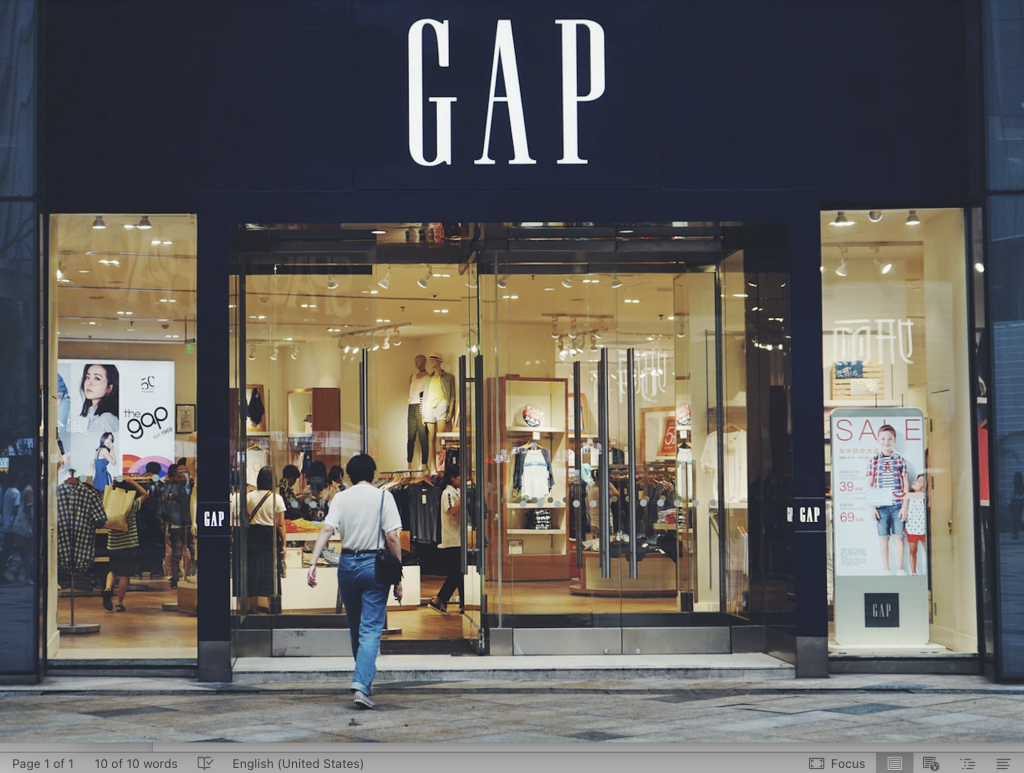Yet another familiar fashion retailer is about to disappear from the British high street. The once-mighty Gap is the latest brand to pull down the shutters. Following in the footsteps (and depleted footfall) of Debenhams, Topshop, and so many others, Gap’s move to online-only selling is further evidence of the accelerating change in consumer direction – away from physical stores and onto our screens.
Gap’s latest move is striking given that until 2008, the U.S. company – which also owns the Banana Republic, Athleta, and Old Navy brands, had been the world’s largest fashion retailer. That year, it relinquished its position at the top of the totem pole to Zara’s parent company, Inditex, and the years that followed have been progressively difficult for companies like Gap. Over the past decade, for instance, Gap’s sales declined as it sought to maintain an appealing mid-market product range at the right price. The retailer came under more pressure from lower-priced fashion competitors – such as H&M and Primark – and rapidly growing online competition. (Gap is also “in talks with its partners to sell its stores in Italy and France,” per Reuters, “as it looks to limit its presence to online in Europe and save costs.”)
In the UK, apparel company Next remains a confident online leader, while the likes of Amazon and ASOS have increased their share of the market. Relatively smaller, more specialized retailers, such as ultra-fast fashion company Boohoo, have also performed notably in the wake of the pandemic, as shoppers were forced to get their fashion fix online when non-essential shops were closed. Boohoo’s acquisition of defunct high street brands, such as Dorothy Perkins and Oasis, as well as other brand partnerships and diversification into the beauty sector, will further add to that company’s appeal.
In addition, the younger consumers who might have formed a new generation of Gap shoppers are turning elsewhere – not only to e-commerce but to social commerce conducted on social media, where they can pre-purchase and buy garments and accessories, and engage in post-purchase chat and entertainment thereafter. (Although, to be fair, Gap has gotten a boost as of late thanks to TikTok, where users have gone crazy over its High Rise Cheeky Straight Jeans and its logo-ed #gaphoodie, prompting a rise in sales, according to Mary Alderete, global head of Gap marketing.)
At the same time, no shortage of these consumers are becoming active participants in buying and selling fashion items through secondary market sites, such as Depop and Vinted, marking a further point of divergence from generations before them.
In this rapidly changing fashion retail environment, American companies like Amazon, Walmart and Target have seen significant growth during the pandemic. However, others, including Gap, have found the online trading environment more problematic. Gap’s online business – which will continue in the UK despite the store sell-offs – is not considered a big player and did not enable the retailer to make up for the lost business from lockdown-shuttered stores.
Generation gap
Looking beyond the impact of COVID-19 on retail and changing consumption patterns of millennial and Gen-Z shoppers, in particular, a more profound problem is at play for Gap: brand identity and position in the larger fashion market. Brand awareness among consumers is likely to remain high, but Gap falls short in terms of being a favorite store for most consumers and/or providing an excellent experience. All the while, in its core mass market segment, newer entrants have found success with more focused and aspirational offers, and more appealing retail experiences.
Across the board, brand touchpoints (i.e., instances in which a customer comes in contact with the brand), which integrate online, mobile and physical store channels, have become much more important for retailers. New technologies to personalize consumers’ shopping experiences and developments with augmented reality and virtual reality devices point the way to a more distinctive and innovative future. Gap has not really addressed these trends in the UK, and a successful sales and marketing formula based on a broad range of clothing for all ages at reasonable prices over many years is difficult to change – as other mid-market retailers, such as Marks & Spencer, have found.
Still yet, location creates a further problem. At this stage in the pandemic, retailers are beginning to assess new formats and different locations. As consumers have returned to shopping more locally, many retailers are looking at opportunities for smaller stores in more convenient places. In particular, they have started to explore ways of integrating stores with their online operations throughout the shopping experience. Gap’s prime store locations with its inevitable high rents and business rates contribute significantly to its costs, while restricting its ability to try new ideas.
With that in mind, maybe it was an inevitable move for the company to close shops and focus on its online business, as the likes of Debenhams have done and others will inevitably opt to do in the future. And as consumers become more aware of sustainability and ethical issues in fashion production and consumption, perhaps the time has come to welcome new thinking about fashion and a different type of shop.
Anthony Kent is a Professor of Fashion Marketing at Nottingham Trent University. (This article was initially published by the Conversation)











